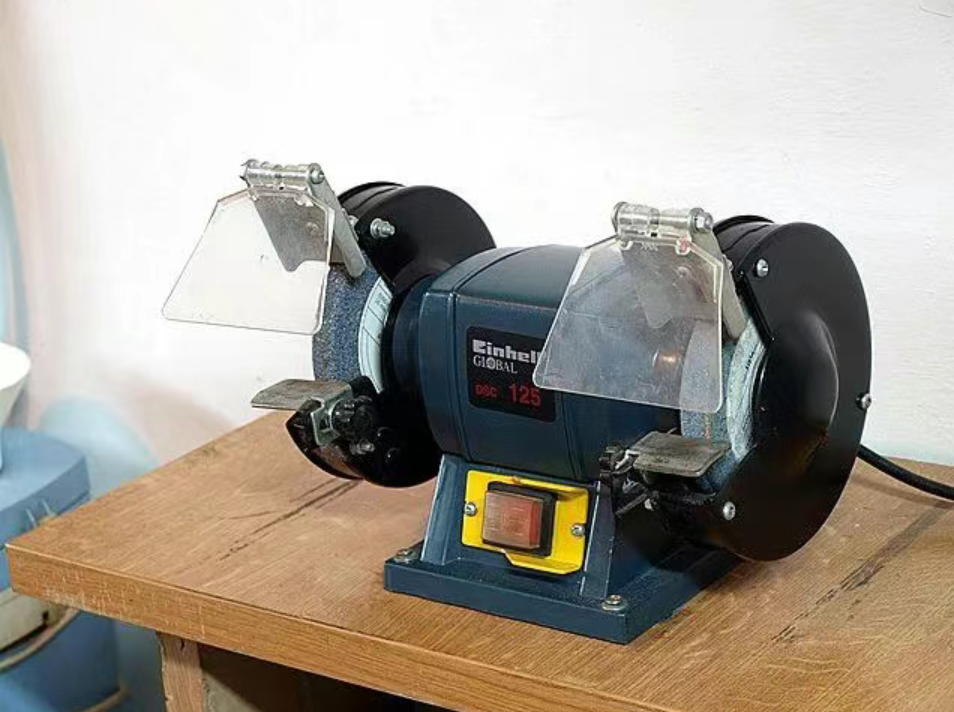I. Common Types and Application Scenarios of Grinding Machines
There are various types of grinding machines, including but not limited to bench grinding machines, vertical grinding machines and Angle grinding machines, etc. Among them, bench and vertical grinding wheels are most commonly used in workshops, factories and maintenance stations, mainly for grinding, dressing and sharpening metal tools and components. Typically, this type of grinding wheel machine is fixedly installed on the worktable or column, equipped with two high-speed rotating ceramic grinding wheels, with a typical rotational speed of up to 3600 RPM (revolutions per minute), and has a strong material removal capacity. Ii. Main Causes of Grinding Wheel Machine Accidents
Improper use can make the grinding wheel machine have high-risk characteristics. Common causes of accidents include: absence or improper installation of protective devices: side guards, workpiece brackets and top guards are not correctly installed or adjusted, causing the grinding wheel to break and fragments to fly, or the operator's body to be caught in rotating parts; Poor equipment maintenance: The grinding wheel is still in use despite having cracks or structural damage. Rotational speed mismatch: The rated rotational speed of the grinding wheel is lower than the actual rotational speed of the grinding wheel machine, and overloading operation leads to cracking. Insufficient operator training: Lack of basic understanding of equipment structure, operating procedures and emergency response; Unclean working environment: messy ground, accumulated dust, flammable materials close to spark sources, etc., causing secondary injuries or fire hazards. Iii. Key Points and Standard Specifications for Safety Operations
To reduce the risk of grinding wheel machine accidents, a systematic safety inspection and training system should be formulated and implemented in accordance with OSHA standards and industry practices. The following are the key inspection points: 1. Inspection of the protective structure: The side guard should cover at least 75% of the wheel diameter of the main shaft, nut and flange, effectively controlling the breakage fragments of the grinding wheel. The distance between the workpiece bracket and the grinding wheel should be no more than 1/8 inch (approximately 3 millimeters) to prevent objects from being sucked in or bounced up. The top adjustable guard should be kept within 1/4 inch (about 6 millimeters) of the upper edge of the grinding wheel to effectively restrain the flying of debris and sparks. 2. Speed matching verification: Before each grinding wheel replacement, it is necessary to compare the maximum speed (RPM) of the grinding wheel with that of the equipment to ensure compatibility and avoid structural damage caused by overspeed operation. The RPM information should be clearly marked on the equipment and the grinding wheel body. 3. Physical inspection before installation: Before installing a new grinding wheel, the following should be carried out: Visual inspection: Check for cracks, notches or delamination. Sound test: Suspend the grinding wheel in the air and tap it gently with a non-metallic object; If the sound is clear and crisp, it indicates good condition; if it is dull and muffled, it needs to be scrapped. 4. Electrical and structural fixation requirements: The grinding wheel machine should be permanently fixed to the operating table or foundation. Equipped with an independent start-stop switch to prevent false start-up; Ensure effective grounding to guarantee electrical safety; If the operation lasts for a long time, a dust collection system or a local exhaust system should be installed. 5. Personal protective equipment and operation training: Operators must wear safety goggles or face masks to prevent eye injuries caused by sparks and debris. Enterprises should organize regular training sessions, covering equipment operation norms, common risk identification, emergency response procedures, etc. Safety education should be incorporated into the onboarding training and on-the-job re-education for new employees, and the training content should be matched with the specific equipment type and usage environment. 4. Conclusion
Although grinding wheels are auxiliary equipment in most workplaces, their high-speed rotation characteristics and potential explosion risks make it necessary to incorporate them into the regular safety management system. Enterprises should establish a regular inspection mechanism for equipment, implement a personnel safety training system, and strictly follow operation norms. They should adopt systematic measures to reduce the accident rate and ensure the safety of employees' lives and the normal production order of the enterprise.





